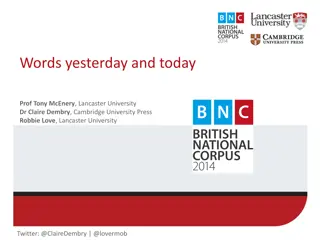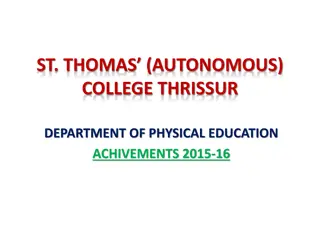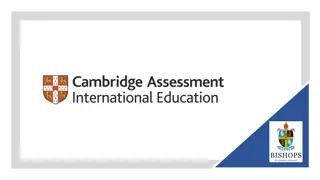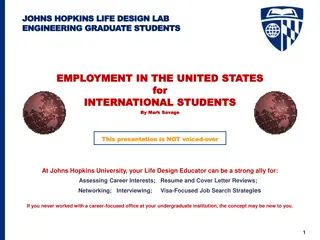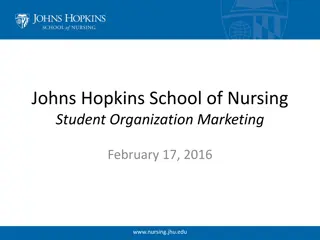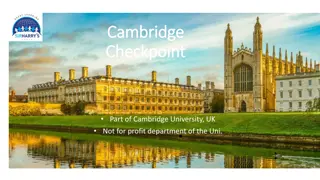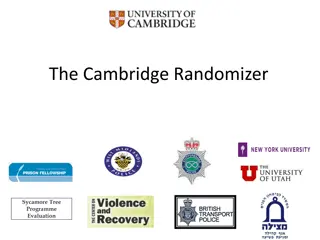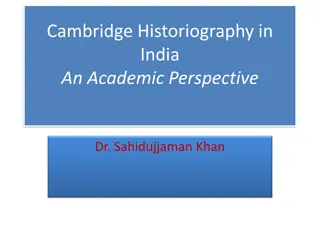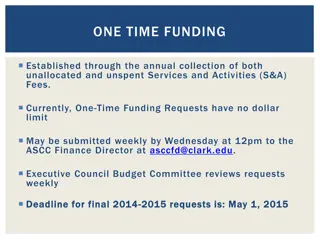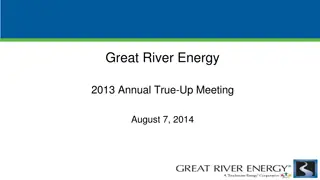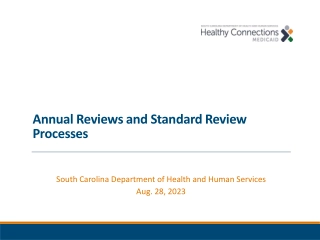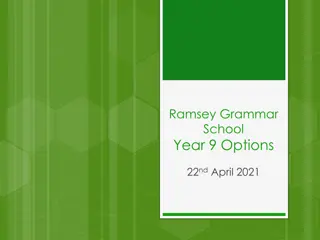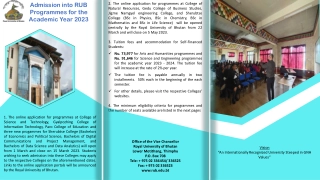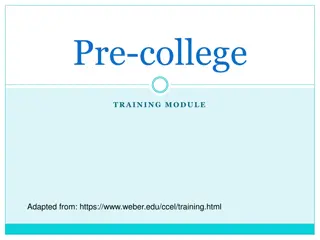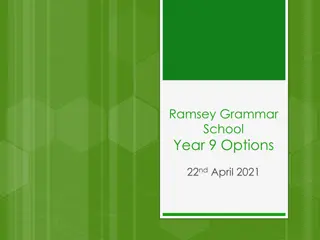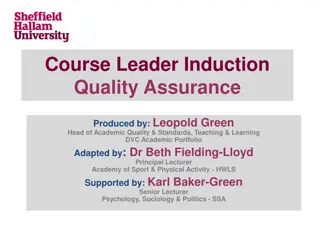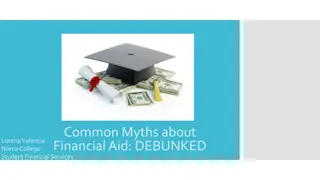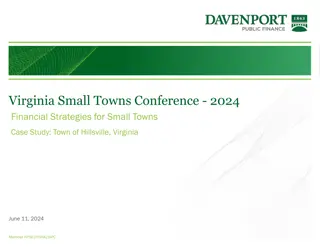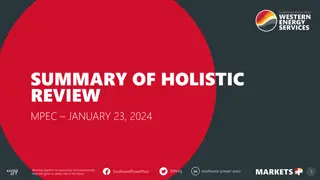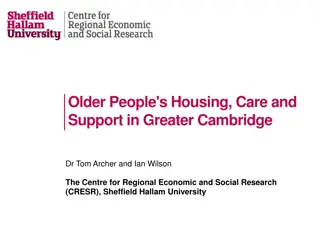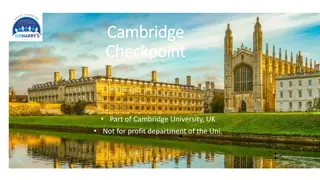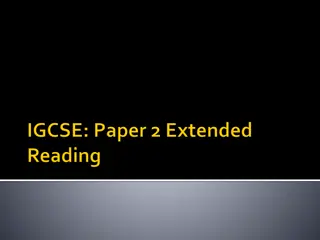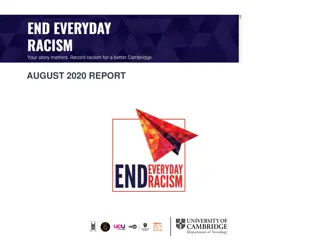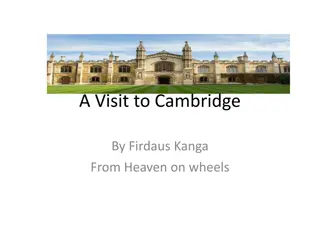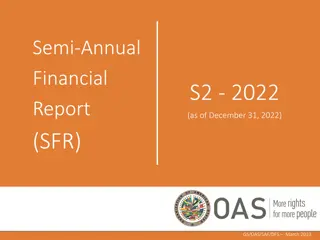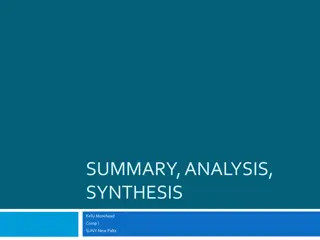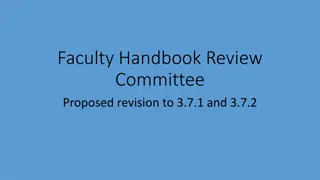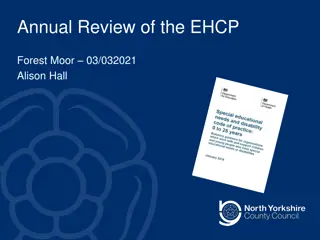St. John's College Cambridge Annual Financial Review 2015/16 - Summary and Analysis
This confidential Annual Financial Review for the Fellows of St. John's College, Cambridge provides detailed insights into the financial performance and outlook for the year 2015/16. It covers the income, expenditure, endowment, and school finances of the College group. The review discusses the operating income, expenditure overview, endowment status, and consolidated financial position after eliminating intra-group transactions. It includes data on tuition fees, rental income, staff costs, choir expenses, and other financial details. The analysis highlights key financial metrics, such as surplus/deficit percentages, retained surplus/deficit, and financial trends over a 10-year period.
Download Presentation

Please find below an Image/Link to download the presentation.
The content on the website is provided AS IS for your information and personal use only. It may not be sold, licensed, or shared on other websites without obtaining consent from the author. Download presentation by click this link. If you encounter any issues during the download, it is possible that the publisher has removed the file from their server.
E N D
Presentation Transcript
ST JOHNS COLLEGE CAMBRIDGE Annual Financial Review 2015/16 November 2016 Confidential for the Fellows of St John s College, Cambridge only 1
Contents 1. Introduction 2. College 2.1 Income & Expenditure - Overview 2.2 Income 2.3 Expenditure 2.4 Capital Expenditure 2.5 Fundraising 2.6 Financial Summary & Outlook 3. The Endowment 4. The School 5. The Consolidated Group 2
1. Introduction This Annual Financial Review describes and analyses the three components of the College group as set out opposite. These three parts of the College are described separately in sections 2, 3 and 4 of this Annual Financial Review, using data drawn from the management accounts. The substantive analysis is for the College and the Endowment, and the finances of the School are only briefly described. The College consolidated accounts for the entire College group including the College, the Endowment and the College School and these are summarised in section 5. The RCCA figures show the consolidated financial performance and position of the College group after eliminating intra-group transactions. statutory Recommended Accounts Cambridge constitute (RCCA) 3
2. The College 2.1 College Income & Expenditure overview Operating Income: Tuition Undergraduates, 10k for Privately funded Undergraduates although the number of UG s has remained consistent. Graduate Tuition Fees rose by 60k with a 22.4% increase in graduate numbers. Fees have increased by 98k for Publicly-funded Rental Income to External Parties ( 228k) plus network charges being amalgamated into the room rents has caused a rise within Accommodation. B&B Income & Service Charges from external events have meant an increase in Catering and Conference. Other Income has risen due to Tourist volumes and admission fee increases in 2015/16 Expenditure: Staff Costs have risen due to the CCFPS deficit payment of 402k implemented within the year and salary increase of 460k. Costs were incurred to develop the Estate Strategy within 2015/16, there were also additional Choir Tour and Concert expenses as well as Choir Recording costs, which increased the Expenditure. Other Operating Student Financial Support has decreased due to a fall in scholarships, Benefactors Scholars fees and maintenance payments. Other Costs: A transfer of property from Operations to Endowment generated a Fixed Asset Revaluation from depreciated book cost to market value. 4
2.1 College Income & Expenditure overview 10 year summary m 06/07 07/08 08/09 09/10 10/11 11/12 12/13 13/14 14/15 15/16 Income 19.2 20.9 21.2 21.9 23.9 24.6 24.8 24.7 26.5 27.3 Expenditure before depreciation & Pension deficit charges 15.7 16.9 19.0 19.7 20.0 21.7 20.7 20.7 21.5 22.9 Expenditure after depreciation & Pension deficit charges 18.8 20.3 22.9 23.8 24.4 25.7 25.6 26.1 27.0 28.4 Surplus / (Deficit) 0.4 0.7 -1.7 -1.9 -0.5 -1.1 -0.8 -1.3 -0.5 -1.1 Surplus/(Deficit) % of Turnover 2.1% 3.1% -7.8% -8.7% -2.1% -4.5% -3.2% -5.4% -1.9% -4.0% Other gains & losses 0.5 -0.5 Retained Surplus/(Deficit) 0.4 0.7 -1.7 -1.9 -0.5 -1.1 -0.8 -1.3 -1.0 -0.5 2012/13 onwards have been adjusted for unspent endowment income and support from reserves . Earlier years have not been adjusted. 5
2.2 College Income - 10 year overview Income grew in 2015/16 compared to the prior year with an increase of 3.1% to 27.31m compared to 26.49m in 2014/15. This was due to an increase in Operating Income across all areas, though these were offset by corresponding growth in related expenditure. Income grew relatively strongly from 2006/07 to 2010/11. Growth then stabilised during 2011/12 to 2013/14, however over 2014/15 and 2015/16 has again begun to rise steadily driven by increases in Endowment distribution and catering and accommodation income. The split of income in each category has remained fairly stable in terms of the % of total income year on year. The importance of the income from the Endowment to the College s finances can be clearly seen accounting for 54% of total income. 6
2.2 College Income - Tuition fees and accommodation Accommodation income Tuition fees Tuition fee income increased by 168k in the year. This is due to an increase of c. 98k (5%) from Undergraduates at the regulated fee rate, 59k (11%) from Graduate Fee Income and 11k (2%) from Privately Funded Undergraduates. Accommodation Income has increased by 295k in the last 12 months, which relates solely to College Rooms & Hostels. This is due to an increase of c. 228k from Rental Income to External Parties, 15/16 being the first year Hostels were let to Lucy Cavendish, generating a greater income than if let to Students within St John's. Student Room Income increased by 51k (5%), due to network charges being amalgamated into the room rents, as well as the rent increase. Small increases in Public Room Hire, due to increased use and Fellows Room Income due to the room rate increase of 1.24% have also contributed. In 2014/15 the Graduate College and University Fees were combined and Colleges now receive a per capita share of the total Colleges portion, removing fee variance for different subjects and resulting in an increase in the fee income for Graduates. 7
2.2 College Income - catering & conferences and other Catering & conference Other income Income from Catering and Conferences rose by 186k year on year. Conference and Events generated an increase of 93k (8.8%), a majority of which related to a rise in B&B Income and Bedrooms used at Events. The BDR generated an increase of 68k (18.4%) which predominately related to Event Breakfast, Lunches and Dinners held in the BDR, which was offset against a reduction in Student Income. Other income accounts for some 6.3% of the College s total. Other operating income comprises IT facilities, Event income and choir tours and concerts. There was a 110k increase in income from other sources in 2015/16. 67k of this related to Tourist Income due to an increase of the admission fee as well as an increase in volumes at the Great Gate. The remainder of Other Income related to School Rents. There was a decrease in Other Education income due to a 70k reduction in income from the Cambridge Bursary Scheme (there was a corresponding reduction in costs of 50k). The KFC increased by 18k against prior year, due to the 3.5% rate increase. Over the ten year period there has been an decline in the volume of external functions, this is due to a change in focus to encourage more college members functions. The dramatic decrease in 13/14 compared to other years related to the close down of the Kitchen facilities for 6 months . 8
2.2 College Income - current use donations and Endowment distribution Current use donations Endowment distribution The income from Current Use donations included in the management accounts, and shown in the chart below, represents gift income which has been matched to expenditure within the year. Some of this income was received in 2015/16 and 0.4m was brought forward from previous years, and unspent donations of 1.5m received in 2015/16 will be used in future years. Since 2007/08 the Endowment distribution has been determined by a spending rule, which until 2014/15 had a target rate of 3.5% and increased the distribution by RPI+1% each year so long as this remained within a cap (and above a floor) of Endowment value. Beginning with 2015/16, the college is now moving towards a more conservative spending rule , with the distribution increasing each year by RPI-0.5%, and the cap and floor reducing to reflect a target spending rate of 3% of Endowment value. The distribution is also adjusted each year for Endowment donations received. Current use donations income was down 11% ( 148k) in the year, this was due to Deferred Capital Grants being included within Current Use Donations up until 2014/15, which have now ceased. The increase since 2007/08 has reflected inflation (since it has bar one year operated within the cap) and the effect of donations being added to the Endowment. The gross distribution from the Endowment increased by 1.2% ( 170k) in 2015/16, and the net distribution after returning unspent income to the Endowment increased by 1.4% ( 208k) 9
2.3 College Expenditure - 10 year overview Expenditure of the College grew in 2015/16 compared to the prior year with an increase of 5.15% to 28.37m compared to 26.98m in 2014/15. This was due to an increase in staff costs and other operating expenses, however these were offset by a reduction in student financial support. Expenditure on staff costs and other operating expenses has remained relatively flat between 2008/09 and 2013/14 however from 2014/15 have increased due to pension deficit payments of 402k. Expenditure on student financial support, interest and depreciation has increased over the years adding to the overall rise in costs. Expenditure excluding the costs of interest and depreciation increased by 6.3% to 22.87m in the year compared to 21.50m in 2014/15. In % terms the only notable change is the increase in staff costs from 40% to 42% of total expenditure having been stable at 40% since 2012/13. 10
2.3 College Expenditure - Staff costs Staff costs rose by 508k year on year. There was an increase of 10% ( 997k) in payroll costs and a decrease of 16.25% (98k) in staff non-payroll costs. Within staff payroll costs, the increase was driven by pension deficit payments and an increase in salaries. Salaries have remained in line or under RPI plus 1% since 2011/12, however the increase in pension costs (both in cash payments and deficit accounting charges) in recent years has pushed total staff costs above the total RPI plus 1% since 2014/15 as illustrated. 11
2.3 College Expenditure - Staff costs 10 Yr CAGR College Staff Costs Stipends / salaries Lump-sum compensation & associated NI Pension past service deficit NI Pensions exc Pension Deficit Accounting Charges Bonuses Overtime Other Benefits Payroll Costs 06/07 6,200 07/08 6,668 08/09 09/10 10/11 11/12 12/13 13/14 14/15 15/16 % change 7,449 7,672 7,613 7,591 1,253 420 611 1,165 222 160 7,898 7,836 8,184 8,644 6% 0% 0% 9% 22% -70% 7% -19% 10% 0% -37% -46% 3% 8% -28% 0% -12% 62% 3% 0% 0% 3% 1% 0 0 0 0 0 0 0 0 0 420 606 1,128 241 196 402 692 1,237 513 1,143 184 221 540 1,233 212 233 603 1,431 222 221 605 1,620 221 188 622 1,001 191 143 614 966 173 121 76 9,785 633 1,016 185 144 140 10,301 56 -11% -4% 0% 3% 154 113 0 0 0 0 10 24 42 8,261 8,886 9,926 10,306 10,214 11,446 9,897 11,298 Agency staff Medical Expenses Scheme Payroll Processing (PSC) Recruitment & Relocation Staff Development Staff Meals Uniforms/Clothing Occupational Health & H&S costs Roundings or prorata difference Non Payroll Costs 73 27 18 83 26 18 41 47 82 28 18 16 53 92 18 18 111 13 19 14 32 186 18 65 19 19 12 40 42 20 16 23 35 74 55 15 128 85 16 53 52 248 26 81 46 17 57 37 1% 5% -1% 22% -1% 4% 0% 0% 8 3 106 42 230 34 42 23 162 22 162 27 195 18 215 18 200 17 220 18 248 23 1 1 1 0 (1) 351 0 4 0 (2) 391 2 4 (1) 556 404 414 387 374 378 608 510 -16% 0% 8% -39% 4% 4% Total College Staff Costs exc Pension Deficit Accounting Charges Pension Deficit Accounting Charges Total College Staff Costs inc Pension Deficit Accounting Charges 8,612 (251) 8,361 9,290 (208) 9,082 10,340 10,693 (150) 10,543 10,605 11,820 (310) 11,510 10,275 374 10,649 10,341 641 10,982 10,909 992 11,901 11,808 601 12,409 3% 0% 4% 17 (7) 10,357 10,598 Total College Staff Costs exc lump-sum 8,612 9,290 10,340 10,693 10,605 10,567 10,275 10,341 10,909 11,808 (1) (2) Academic Includes staff costs for teaching by our own Fellows, but does not include teaching costs of supervisors from outside the College who are not paid through the payroll. Staff costs represent 42% of the total expenditure of the College 12
2.3 College Expenditure - Staff costs cont. The chart opposite sets out staff headcount by year and activity. The full-time equivalent (FTE) figures are those management/administration roles and all Assistant Staff for the past ten years. College Officers are now included department staff numbers, as their costs are included in the activity costs in the following chart. for Fellows in within the There was a steady reduction in staff numbers in the College between 2006/07 and 2013/14. The main decreases occurred in Estates Domestic (mostly in Housekeeping and Porters), however staff numbers increased within Education and Development. Since 2014/15 staff numbers have slowly increased as it became apparent that numbers within Housekeeping and Porters were stretched. There has however been a reduction in staff within the Catering and Conference department in the past three years, meaning that they are more reliant on Casual/Agency staff. 13
2.3 College Expenditure - Other operating costs and student financial support Other operating costs Student financial support Other operating costs account for 27.34% of the College s total expenditure and has increased by 597k (8.35%) year on year. There has been a steady increase in student financial support costs over the last nine years, however there has been a decrease of 5% in 2015/16. Other expenses include professional fees and event costs. All areas of support have increased since 2005/06. The largest increases had been in merit based graduate scholarships (funded scholarships and the Benefactors Scholars/Supplementary Emoluments Scheme), this area has decreased from 1,182k to 923k year on year due to a fall of 170k in funded scholarships and a decrease of 89K in Benefactors Scholars fees and maintenance payments. Undergraduate needs based support (principally bursaries) decreased by 71k year on year and undergraduate funded scholarships increased by 41k. Undergraduate merit based prizes increased by 122k due to the introduction of Pre-Admissions prizes. The main increases have been within Other Estate Domestic expenditure and Chapel & Choir costs. There was a 225k increase in Other Estate Domestic expenditure in 2015/16 predominately due to the development of the Estates Strategy with a further 174k relating to the Chapel & Choir which was due to additional Tour and Concert expenses as well as Choir Recording costs. Much of what has been achieved is directly due to the generosity of College benefactors, as much of the College s overall fundraising has been for student support. 14
2.3 College Expenditure - Interest and depreciation Interest Depreciation Depreciation was 5.06m in 2015/16, which was in line with the previous year and which will remain consistent until the next big building project. The depreciation charge increased in 2014/15 compared to 2013/14 due to the completion of Cripps Phase 3 and the refurbishment of the School of Pythagoras. In 2006 the College entered into a number of bank facilities with Barclays to fund the 9 year building refurbishment programme which was concluded in 2014/15. The full facility is 20m, however 4.3m has been on-lent and will be repaid by the School. Interest has remained constant at 1.08m since 2013/14 when a 10 million 5 year term loan with RBS was entered into, 1.1m of which was repaid in May 2016, as well as a 5 year 5m Revolving Credit Facility entered into with Barclays (which is currently undrawn). These facilities were all interest only at the point of execution, however capital repayments commenced in 2015/16. Accounting depreciation has a significant effect on the operating surplus/deficit of the College. Operational buildings are valued on a depreciated replacement value basis and depreciated on a straight-line basis over 50 years. The level of depreciation of operational buildings that arises from these policies is estimated to be broadly equivalent to the long-term annual average capital expenditure the College expects to have to spend on its buildings. However it is significantly less than the actual capital expenditure that the College has been spending over the 9 year refurbishment programme from 2006 to 2014 which represented a catchup following a period of under-expenditure on building refurbishment work in the early 2000s. As a consequence of the College incurring this borrowing to fund the building refurbishment, debt interest costs have risen steadily and substantially since 2006. It is a priority following the completion of the building refurbishment programme in 2014/15, to repay the two 2013 facilities as soon as possible, with the 2006 facility being amortised over the period 2016-36. 15
2.4 College Capital Expenditure From 2006/07 - 2014/15 the College undertook a large capital programme, from October 2015 the College has been in a state of moratorium. This has mainly related to building refurbishment but has also included furniture (with the major items being linked to building refurbishment), IT and other projects. The table shows operational capital expenditure over the last 10 years and heritage assets, which are non-cash additions to the fixed assets of the College. The chart opposite shows the operational capital expenditure of the College, and so excludes heritage assets. 16
2.4 College Capital Expenditure Buildings Capital refurbishment is shown in the chart opposite along with building maintenance costs of a revenue cost nature to show the overall expenditure on buildings. Industry benchmarks indicate that 1.5-2.0% of the replacement (insurance) cost of buildings typically needs to be spent annually on maintenance (including both revenue costs and capital costs) to maintain them in perpetuity in a like-for-like state, and the levels of these benchmarks are indicated in the chart. expenditure specifically on building As can be seen, expenditure from 2006/07 2013/14 has been very substantial and well in excess of benchmark long-run averages. This reflects a concentration of facilities reaching the end of their useful lives at the same time, after below long-run average expenditure in previous years. Forecast expenditure for the next 3 years is drawn from the version of the Medium Term Buildings Programme submitted alongside the 2016/17 budget. It reflects a period of minimal capital expenditure on buildings, which is necessary to enable the College to recover financially from the impact of such a period of major and prolonged expenditure. 17
2.5 College Fundraising The chart below shows cash receipts from donations and bequests received from 1996/97 to 2015/16 (years ending 30 June). Cash receipts are clearly different from fundraising progress as a significant part of our funds raised is in the form of pledges to be paid over several years. In 1996/97 the Johnian Office was set up, which yielded donations ranging from 500k - 1.5m each year over the course of 9 years. In 2005/06 the College began a more pro-active in regards to fundraising with the quiet phase of the public Campaign launched in 2007, with clear results over the last 11 years. Donations and bequests received during 2015/16 were 3.98m. Of this total, 1.87m related to current use gifts, 0.65m to capital grants (for buildings) and 1.46m to new Endowments. There were no donations of heritage assets during the year. Current use gifts increased substantially due to monies received in 2015 /16 to be used for the new Studentships scheme in 2016/17. 18
2.6 College Financial summary and outlook College financial result in 2015/16 Before depreciation and pension deficit accounting charges (non-cash items), the College had a surplus of 4.4m. The College incurred a deficit (after depreciation of 5.1m and pension deficit accounting charges of 0.4m) of 1.1m (3.87% of turnover) which has increased compared to 2014/15 due to a rise in Expenditure, which exceeded the rise in Operating income. The main drivers of the decrease in performance were: An increase in Staff costs due to the Pension Deficit payments and salary increases within 2015/16. The development of the Estates Strategy. An increase in Chapel & Choir Tour and Concert expenses as well as Choir Recording costs. Challenges Suggested responses Repay debt and restore cash (with more building refurbishment looming) Judicious capital expenditure Seek I&E improvements not materially impacting charitable activities Income & expenditure pressures: Static 9,000 fees Staff costs increasing (pension costs, NI rises, increasing staff numbers) Tapering of growth of Endowment distribution Rigorous budget round 2017/18 In new campaign, strive for a reasonable degree of flexible funding 19
3. The Endowment 3. The Endowment summary of restricted funds Within the Endowment there are a number of funds with restricted purposes, arising predominantly from past donations to the College. The value of these restricted funds (including those relating to the School) was 98.5m at 30 June 2016. The purposes of these funds are shown in the charts by percentage of total funds (below) and by value (opposite). Value of Restricted Funds at 30 June 2016 1% 1% Scholarships & Awards 7% 1%3% Research 3% Education 3% Field Sports 7% Chapel & Choir School Library 63% 11% LMBC Maintenance Other 20
4. The School 4. The School Income & Expenditure The Governors of St John s College School are responsible for educational policy, administration and management of the finances of the School, other than certain major decisions which are decided upon by the College Council. The School is expected to be financially self-standing. Set out below is a summary of School income and expenditure for the last ten years. It should be noted that from 2012/13, the School has brought its financial year into line with that of the College, i.e. to 30 June. Previously the School year end was 31 August. This affected the total expenditure for 2012/13 as the accounts covered only 10 months, but had little impact on the income as school fees are paid early in the financial year. 21
4. The School Fundraising and endowment funds The chart opposite shows the capital gifts received by the School since 1995/96. There have been no gifts for the last four financial years. The School has restricted funds within the College s CTF, which earn a distribution each year. This is included in the income figures in the I&E chart on the previous page. The total value of restricted funds held on behalf of the School within the CTF is shown in the following chart. 22
5. The Consolidated Group 5. The Consolidated Group Income & Expenditure The table below shows the income and expenditure from the College s statutory (RCCA) consolidated accounts (which include the College, the Endowment and the College School including all subsidiaries) over the last 10 years. After a two year period to 2007/08 in which income grew faster than expenditure, leading to a move into a small surplus, a period of rapid cost growth arising from the 2006-2008 national pay award led to significant deficit positions in 2008/09 and 2009/10. There was an improved bottom line result with lower deficits in the following three years, with the change to School year-end driving the reduction in expenditure in 2012/13, which flattered results. The sharp rise in expenditure in 2013/14 reflected a full year s expenditure for the school (in contrast to the previous year) plus some real cash rises in expenditure such as debt interest and investment property refurbishment and development expenditure, plus some accounting cost increases such as the FRS17 pension adjustment and increased depreciation. The rise in income was muted because of an inability to reflect in our RCCA accounts, the full Endowment distribution from expendable funds. The figures for 2014/15 and 2015/16 are reported under the changes imposed by FRS102. The main impact of these changes is to include all donations received including endowment donations in income. This means that the income and deficit figures for 2014/15 onwards are not directly comparable to earlier years. The increase in deficit is not however, indicative of a deterioration in the financial performance of the College. exc lump-sum 11/12 Restated Income & Expenditure m 03/04 04/05 05/06 06/07 07/08 08/09 09/10 10/11 12/13 13/14 14/15 15/16 Income (excluding unspent restricted income) Expenditure (excluding lump-sum compensation) Retained surplus/(deficit) for the year Surplus/(deficit) before other gains and losses exc new endowments & capital grants 21.5 22.5 (1.0) 23.2 23.6 (0.4) 25.1 25.1 26.7 26.3 0.4 28.7 28.5 0.2 29.5 30.8 (1.3) 30.1 32.1 (2.0) 32.1 32.7 (0.6) 32.9 32.7 0.2 32.5 33.1 (0.6) 32.8 35.5 (2.7) 38.4 38.8 (0.4) 39.3 39.9 (0.6) 2.3% 2.8% 50.0% - (3.6) (2.7) -25.0% 23
5. The Consolidated Group Income Over the last year the RCCA format was modified to reflect FRS102 reporting changes and 2014/15 figures were restated, however there have been no dramatic shifts in the balance of the group s income. There has been a reasonably stable breakdown of income by type over the last 2 years, with increases in Residence and Catering External of 0.3m, and Donations of 0.2m. These increases are mainly due to Rental Income from Lucy Cavendish, generating a greater income from the hostels than if let to Students, an increased volume of B&B bookings compared to 2014/15 and the announcement of the Studentship awards resulting in increased current use donations. 25
5. The Consolidated Group Expenditure Over the last year the RCCA format was modified to reflect FRS102 reporting changes and 2014/15 figures were restated, however there have been no dramatic shifts in the balance of the group s expenditure. There has been a reasonably stable breakdown of expenditure by type over the last 2 years. Since the completion of the building refurbishment projects in 2014/15 depreciation has remained flat. Interest has remained constant since 2013/14 when a 10 million 5 year term loan with RBS was entered into to fund the building refurbishment programme. There was an increase in School expenditure in 2015/16 of 0.6m compared to prior year. 26
5. The Consolidated Group Balance sheet Restated Consolidated Balance Sheet m 14/15 15/16 % change Actual change Tangible assets Investments Current assets Total Assets 253.1 462.6 22.5 738.3 251.9 489.1 33.9 774.9 -0.51% 5.73% 50.44% 4.95% (1.3) 26.5 11.4 36.6 The College group is an asset heavy, income light organisation, with a very significant balance sheet. Less liabilities: General creditors Pension deficit Loan Total Liabilities The assets comprise largely of buildings (forming most of tangible assets ) and the investments in our Endowment. Current assets is often higher than might be typical because of Endowment cash holdings falling under this heading. 7.9 11.6 29.6 49.0 9.9 12.2 28.3 50.4 26.20% 4.93% -4.21% 2.84% 2.1 0.6 (1.2) 1.4 The group has typical levels of general creditor liabilities. Other liabilities have been growing as pension deficits have increased and as debt has been taken on to fund the building refurbishment programme. Whilst liabilities remain modest in relation to the size of the balance sheet, the plan is to bring them down over time. The CCFPS deficit should come down as a result of deficit reduction payments (though pension deficits have something of the Forth Road Bridge about them). However, the USS deficit which was not previously recognised on the Balance Sheet has now been recognised from 2014/15 onwards with the implementation of FRS102. Debt was reduced as planned by 1.1m against the RBS 10m loan in May 2016. Net Assets 689.3 724.5 5.11% 35.2 Capital & Reserves 689.3 724.5 5.10% 35.2 Net Assets (assets less liabilities) have grown steadily and overall the College group continues to have a very strong balance sheet. 27
5. The Consolidated Group Capital expenditure In 2014/15 the College reached the end of a major building refurbishment programme which formed the bulk of group capital expenditure. However, the Endowment has also incurred capital expenditure on investment assets and the School has also carried out a significant building refurbishment and construction programme. 28
Appendices I II Structure of College Activities Size of the College 29
Appendix I: Structure of College Activities The College and its income and expenditure is structured for accounting purposes according to the chart below. Other Income & Expenditure College Operations Operational Interest Core/Ancillary Support School Rent Catering & Conference Education Other Income Debt Interest & Bank Charges Extra-Curricular Estates (Domestic) Depreciation Research IT Pension Deficit Accounting Charges Library & Archives Administration Donations & Contributions Chapel & Choir Development Exceptional Payroll Domus/Fellows Steward Other Expenditure 30
Appendix I: Structure of College Activities cont. College Operations Core and ancillary activities Education: this comprises admissions, access and outreach, teaching, tutorial, scholarships/awards and the health centre (since this is mainly associated with providing services to students). Extra-Curricular: this comprises JUMSECA, the Associated Societies, the Field Clubs, the Fitness Centre, the GAC, the LMBC, and extracurricular Music activities. Research: this comprises activities in research and scholarship (other than those relating specifically to junior members) including Research Fellows, College Research Associates, Postdoctoral researchers, Research Associates (Naden, etc.), Beaufort Visiting Scholars, lectures, and grants to Fellows and others. Library & Archives: the College library, both old and new, as well as the Archives and the biographical register. Chapel & Choir: the running of the Chapel and the Choir (including payments to the College School in respect of the support of the costs of chorister education). Domus/Fellows Steward: activities relating to the running of the domestic aspects of the Fellowship, including Fellows meals, College functions, the Green Room and Pictures (the costs of providing Fellows rooms falls within Estates (Domestic)). Support activities Catering & Conference: this comprises catering for Fellows, students and staff as well as private catering and conference services for third- party customers. Estates (Domestic): the College s domestic estates and facilities including Housekeeping (cleaning of College rooms, Hostels and Furnished Lets, and the Master s Lodge as well as Furniture), Gardens, Maintenance, Porters, Tourism & Merchandise and Utilities & Insurance. IT: the College s IT team and IT projects. 31
Appendix I: Structure of College Activities cont. Administration: those departments and offices that provide services and support to a range of College activities, namely Master s and President s Offices, Finance, Bursary, Domestic Bursar, Communications and Human Resources. Development: the alumni relations and fundraising activities of the College carried out by the Development Office. Other income & expenditure Operational interest: interest received on operational cash balances. School rent: the rent received from St John s College School. Other income: indirect VAT recovery, recharges of administrative Endowment costs borne by Operations, covenants from operational subsidiaries, and any proceeds of asset sales. Debt interest and bank charges: charges and interest associated with the bank facilities taken out to help fund the building refurbishment programme between 2006 2015. Depreciation: the accounting measure of the amount of the economic benefit of the College s fixed assets that has been consumed during the period. Pension Deficit Accounting Charges: the pension deficit accounting charge adjustment for the CCFPS assistant staff pension scheme, the USS pension scheme and the Church of England pension scheme. Donations & University Contribution: charitable donations made by the College as well as University Contribution which, through the Colleges Fund, supports Colleges with smaller endowments. Exceptional payroll costs: the lump-sum payments made to staff in compensation for the ending of the long-service pay scheme, together with other associated costs. Other expenditure: Any other expenditure not falling within the categories above. 32
Appendix II: Size of the College Undergraduate numbers have been relatively stable since the 1960 s. Graduate numbers have increased steadily since the early 1950 s. These numbers include non fee-paying students e.g. exchange students. 33
Appendix II: Size of the College cont. Title A: after a decline in the early 1950 s, numbers have remained fairly stable but with a slight peak at the turn of the century Title B: after a steady and significant rise from the end of the War to the end of the 1960 s, numbers have remained fairly steady Title C: after remaining steady from the end of the War to the late 1980 s, numbers increased somewhat over the following decade, then increased steeply from around the turn of the century, though reduced slightly in recent years Title D: from being a negligible number until the mid 1950 s the numbers have risen steadily and significantly (from 3 in 1945 to 36 in 2016, principally as the number of retired Fellows has increased Title E: after remaining fairly steady until the late 1970 s, numbers increased substantially throughout the 1980 s and were then fairly stable, although the last few years have seen a further increase, partly also reflecting retired Fellows 34 In overall terms, the numbers of Fellows have more than doubled over the last 60 years.
Appendix II: Size of the College cont. The chart opposite shows the number of Fellows and the number of students, indexed from 1955 (chosen as the first normal year following the post-War increase in student numbers). The number of Fellows has more than doubled whilst the number of students has increased by some 50%. 35


